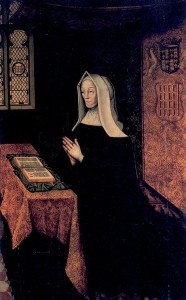 On 29th June 1509, just two months after the death of her son, Henry VII, and the accession of her grandson, Henry VIII, Lady Margaret Beaufort died at the age of sixty-six. Her good friend, John Fisher, Bishop of Rochester, attended the dying Margaret and was able to perform last rites. Fisher also preached the sermon at Margaret’s funeral, where he likened her to the Biblical “blessyd woman Martha” in four ways:
On 29th June 1509, just two months after the death of her son, Henry VII, and the accession of her grandson, Henry VIII, Lady Margaret Beaufort died at the age of sixty-six. Her good friend, John Fisher, Bishop of Rochester, attended the dying Margaret and was able to perform last rites. Fisher also preached the sermon at Margaret’s funeral, where he likened her to the Biblical “blessyd woman Martha” in four ways:
- “In nobleness of Person”
- “In discypline of their Bodys”
- “In orderyng of their Souls to God
- “In Hospytalytyes kepying, and charytable dealyng to their Neighbours.”
According to Fisher, as Margaret was dying she “confessed assuredly that in that Sacrament was conteyned Chryst Jhesu, the Sone of God, that dyed for wretched Synners upon the Crosse, in whome holly she putte her truste and confidence. These same wordes almoost, that Martha confessed in the end of thys Gospell. Ego credidi, quia tu es Christus films Dei, qui in mundum venisti, that is to save, I have byleved that thou art Cryste the Son of God which came into thys worlde” and then she passed away. It was the end of the matriarch of the Tudor dynasty and a formidable woman. You can read more about her in my article “Lady Margaret Beaufort”.
Fisher’s funeral sermon can be read online at http://archive.org/stream/funeralsermonofm00fishuoft#page/106/mode/2up